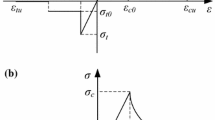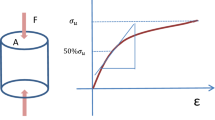Abstract
A tensile test using a half ring (HR) shaped specimen is attempted for the determination of the tensile strength of rock materials. The HR test is a 3-point bend test similar to the semicircular bend (SCB) test. However, the HR specimen is a curved prismatic bar. The theoretical tensile strength of this special bar can be obtained by an analytical formula derived from a basic theory of strength of materials. Owing to the eccentricity of the HR specimen, the possibility for a single tensile fracture to begin at the intended location can increase. This may give results that are more accurate than the conventional bending tests. In this paper, after the concept and formula of the HR test are introduced, its applicability to brittle rocks is investigated by FEM simulations and laboratory tests. In the processes, the theories of the Brazilian test and a special SCB test, which is an alternative to the Brazilian test, are used to examine the accuracy of the HR test.
Similar content being viewed by others
References
Aliha, M.R.M., 2014, Indirect tensile test assessments for rock materials using 3-D disc-type specimens. Arabian Journal of Geoscience, 7, 4757–4766.
Beer, F.P., Johnston Jr., E.R., DeWolf, J.T., and Mzurek, D.F., 2009, Mechanics of Materials (5th edition). McGraw-Hill, Singapore, 782 p.
Boresi, A.P. and Chong, K.P., 2000, Elasticity in Engineering Mechanics (2nd edition). John Wiley & Sons, Singapore, 567 p.
Colback, P.S., 1967, An analysis of brittle fracture initiation and propagation in the Brazilian test. Proceedings of the 1st Congress of the International Society of Rock Mechanics, Lisbon, Sep. 25–Oct. 1, 1966, p. 385–391.
Dai, F., Xia, K., and Tang, L., 2010, Rate dependence of the flexural tensile strength of Laurentian granite. International Journal of Rock Mechanics and Mining Sciences, 47, 469–475.
Dan, D.Q., Konietzky, H., and Herbst, M., 2013, Brazilian tensile strength tests on some anisotropic rocks. International Journal of Rock Mechanics and Mining Sciences, 58, 1–7.
Fairhurst, C., 1964, On the validity of the Brazilian test for brittle materials. International Journal of Rock Mechanics and Mining Sciences, 1, 47–54.
ISRM (International Society for Rock Mechanics), 1978, Suggested methods for determining tensile strength of rock materials. International Journal of Rock Mechanics and Mining Sciences & Geomechanics Abstracts, 15, 99–103.
Japaridze, L., 2015, Stress-deformed state of cylindrical specimens during indirect tensile strength testing. Journal of Rock Mechanics and Geotechnical Engineering, 7, 509–518.
Kedward, K.T., Wilson, R.S., and McLean, S.K., 1989, Flexure of simply curved composite shapes. Composites, 20, 527–536.
Li, D.Y., Wang, T., Cheng, T.J., and Sun, X.L., 2016, Static and dynamic tensile failure characteristics of rock based on splitting test of circular ring. Transactions of Nonferrous Metals Society of China, 26, 1912–1918.
Li, D.Y. and Wong, L.N.Y., 2013, The Brazilian disc test for rock mechanics applications: review and new insights. Rock Mechanics and Rock Engineering, 46, 269–287.
LSTC (Livermore Software Technology Corporation), 2017, LS-DYNA Keyword User’s Manual. Volume II: Material Models. Livermore Software Technology Corporation, Livermore, p. 3–31.
Mellor, M. and Hawkes, I., 1971, Measurement of tensile strength by diametral compression of discs and annuli. Engineering Geology, 5, 173–225.
Obert, L. and Duvall, W.I., 1967, Rock Mechanics and the Design of Structures in Rock. John Willey & Sons, New York, 650 p.
Phoon, K.K. and Retief, J.V. (eds.), 2016, Reliability of Geotechnical Structures in ISO2394. CRC Press/Balkema, London, 230 p.
Raj, K. and Pedram, R., 2015, Correlations between direct and indirect strength test methods. International Journal of Mining Science and Technology, 25, 355–360.
Timoshenko, S.P. and Goodier, J.N., 1970, Theory of Elasticity (3rd edition). McGraw-Hill, New York, 615 p.
Acknowledgments
This work was supported by the Basic Research and Development Project of the Korea Institute of Geoscience and Mineral Resources (KIGAM, Project code No. GP2017-016), which was funded by the Ministry of Science, ICT and Future Planning of Korea. This research was also partly supported by the Basic Research Program through the National Research Foundation of Korea (NRF) funded by the Ministry of Education (NRF-2016R1D1A1A09917357).
Author information
Authors and Affiliations
Corresponding author
Rights and permissions
About this article
Cite this article
Choi, BH., Lee, YK., Park, C. et al. Measurement of tensile strength of brittle rocks using a half ring shaped specimen. Geosci J 23, 649–660 (2019). https://doi.org/10.1007/s12303-018-0060-x
Received:
Accepted:
Published:
Issue Date:
DOI: https://doi.org/10.1007/s12303-018-0060-x




